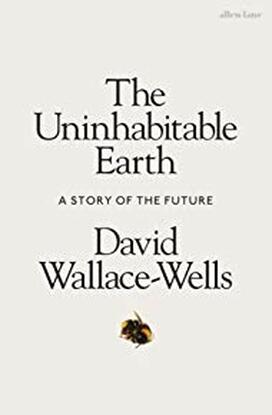The Uninhabitable Earth, A Story of the Future
John Foster's review of 'The Uninhabitable Earth'

Published by Allen Lane, 2019
This is a remarkable book, and nothing that I say subsequently is meant to dissuade you from going right out and buying it – for yourself, as a compellingly lucid account of our climate plight in all its ramifications, or as the ideal gift for anyone you know who still needs convincing. Its first three parts comprise the starkest demonstration of climate honesty that we have had to date.
Yet Wallace-Wells both gets it and doesn’t get it. The book recognises the facts and bluntly canvasses the implications, but defaults to a kind of tormented optimism when it comes to the necessary responses. This stance has certainly a lot more to be said for it than most of what is now being written about our prospects. But does it, finally, face up to climate reality? – or does it, like Janus, the double-faced Roman god of endings and beginnings (for whom the month of January is named), hark back in the very stroke of trying to look forward? That is a big question for Green House, which if it is going to make facing up one of its signature themes needs to be very clear what counts. It is also, of course, and more importantly, going to become an increasingly big question for everyone who wants to think straight about these issues.
Hard truths
The book doesn’t, indeed, just recognise the facts – it vigorously forces them on our attention, in language which combines relentless focus with a contained but evidently raw passion. This is in itself a startling achievement: as Wallace-Wells notes, “rhetoric often fails us on climate because the only factually appropriate language is of a kind we’ve been trained, by a buoyant culture of sunny-side-up optimism, to dismiss, categorically, as hyperbole”. But here, “the facts are hysterical…” (p.29). Especially while reading the first part, ‘Cascades’ (which is the author’s term for the way it is all going to run away with us), one’s pencil leaps to mark passage after quotable passage – each a succinctly eloquent encapsulation of some crucial aspect of oncoming danger. For example:
- “140 million [climate refugees] by 2050, the World Bank estimates, meaning more than a hundred times Europe’s Syria crisis.” (p.7)
- “The Kyoto Protocol achieved, practically, nothing; in the twenty years since, despite all of our climate advocacy and legislation and progress on green energy, we have produced more emissions than in the twenty years before.” (p.9)
- “150 million more people would die from air pollution alone in a 2-degree warmer world that in a 1.5-degree warmer one…Numbers that large can be hard to grasp, but 150 million is the equivalent of twenty-five Holocausts.” (p.28)
Part II of the book (‘Elements of Chaos’) then goes into more finely-grained detail about these cascading effects, tracking the implications of our current trajectory (towards at least +3.2 deg C, given failure to make serious progress towards the Paris targets) across a range of climate consequences: heat-waves (especially their effects on city living), air pollution, food supply and quality, sea-level rise and inland flooding, other ocean effects, freshwater availability, increasing frequency and fierceness of wildfires, the trend to more extreme weather events such as hurricanes, and of course the associated economic disruption and violence (resource wars and related results of climate stress) attending all this. Each of these short chapters reviews the present conclusions of the relevant science in a spirit of refusing to find comfort in implausibly best-case scenarios. They show decisively that what is likely to result from now-inevitable warming under any one of these separate heads can fairly be called disastrous, while also building up a frightening picture of how they all interact and mutually reinforce one another.
Part III of the book is called ‘The Climate Kaleidoscope’, the metaphor pointing to how we can be intrigued, even mesmerised, by all these shifting and combining possibilities of disaster, without ever seeing them clearly enough for decisive action. The various available framings considered include the narratives which we adopt about ourselves, in popular culture and elsewhere, our attitudes to capitalism and to new technology, the politics of consumption and the sense which we might try to make of the end of progress and the associated challenges to our ethical attitudes. Here too the insights are sharply expressed and (for conventional thinking of all kinds) very uncomfortable:
“Many on the Left point to the all-encompassing system, saying that industrial capitalism is to blame. It is. But saying so does not name an antagonist; it names a toxic investment vehicle with most of the world as stakeholders, many of whom eagerly bought in. And who in fact quite enjoy their present way of life.” (pp.148-9)
“Conscious consumption and wellness are both cop-outs, arising from that basic promise extended by neoliberalism: that consumer choices can be a substitute for political action…” (p.189)
Still in command?
So why, amidst all this uncompromising and necessary honesty, do I say that Wallace-Wells doesn’t get it, or at best both gets it and doesn’t? The key issue concerns what honesty allows us still to hope for. His first chapter is, as I said, impressively eloquent and persuasive – until suddenly we come on this:
“Global warming is, after all, a human invention. And the flip side of our real-time guilt is that we remain in command.” (p.30)
But that is just to channel (presumably, since he doesn’t actually quote or reference the book) the Mark Lynas of The God Species. The implied claim is a complete non sequitur, as is made even clearer when it is later reframed explicitly as: “If humans are responsible for the problem they must be capable of undoing it” (p.220). (To see how grossly that fails to follow, try substituting “the Holocaust” for “the problem” here.) But the logical weakness is disguised from view by the same device, almost in terms, as Lynas himself uses in his own book: the claim that we engineered this mess, so we must be able to engineer an escape from it. Nor can this be just a passing slip, because Wallace-Wells says it twice, in virtually the same words, both at the end of Part I and in the concluding chapter And as I have pointed out against Lynas, (see p.32-3 of After Sustainability) this is just to commit the informal fallacy of equivocation – using different senses of the same term in the premise and conclusion of what is meant to be an argument. Describing as engineering both our overwhelmingly unintentional triggering of climate change, and the massive, globally-co-ordinated deliberate interventions by which, at least in certain techno-heroic fantasies, we might try to address it, and then supposing on such merely verbal grounds that our having brought about the former means we can aspire to achieve the latter, is productive not only of obfuscation, but of real and present peril – since it is also what licenses the hubris of the central Lynas trope, which Wells repeats (presumably, again, unaware that he is doing so): “We have an idiomatic name for those who hold the fate of the world in their hands, as we do: gods” (p.220).
But we aren’t, of course, gods – we are a clever, imaginative, dangerously over-confident and desperately fallible primate species, and our being so is surely a centrally real feature of our current plight. So if the stronger parts of Wallace-Wells’ book are indeed facing up to climate reality, we can’t help finding him still, at the same time, facing firmly away from it and back towards Enlightenment dreams of a humanly-managed planet.
That doubleness of gaze very clearly involves, at any rate for a non-god, strains and tensions. It is not just a matter of his referring with quite justified scorn to the “sunny-side-up optimism” of our culture, and then two pages later insisting that “I am optimistic”. It is not even that the book appears to be marketed in the US with a different and more reassuring subtitle – “Life after Warming” – however awkwardly that sits with “The Uninhabitable Earth”. The effect goes deeper: there is a profound underlying conflict of attitudes, which emerges perhaps most clearly in the short chapter constituting Part IV. Here, Wallace-Wells abruptly broadens his focus, considering various speculations as to why human beings have not been able to find intelligent life elsewhere in the universe. (He doesn’t canvass the thought that its intelligence is precisely what has encouraged it to avoid us, thus far successfully…) This leads him to the Anthropic Principle, the idea that we shouldn’t be startled by our apparent uniqueness, since, as he puts it, “something like the world we live on and the one we’ve built are a sort of logical inevitability, given that we are asking these questions at all” (p.225) Humanity may be cosmically speaking a freak occurrence with huge odds against it, but that can’t render us implausible to ourselves, any more than the lottery winner for whom a million-to-one chance has paid off has to think that statistically he can’t have really won. Wallace-Wells tries to draw comfort from this sense of our cosmic specialness, recognition of which he thinks might spur us at last to act as one people, planet-wide. But of course, the lottery winner who has blown it all and ended up an addict in rags has still been fingered by Fate, he has just failed to use his winnings well – which could very easily indeed turn out to be the position of humanity by the twenty-second century. And while from the cosmic perspective so gratuitously dragged in here, this will hardly matter, from that of our grandchildren it will matter enormously. The irreconcilability of these perspectives is left completely unresolved at the end of the book; indeed, it would seem that the main purpose of this last chapter is to allow the author to conclude with a gesture of hopefulness which is at the same time, and quite unstably, a kind of shrug:
“The Voyager I space probe gave us the ‘Pale Blue Dot’ – the inescapable smallness, and fragility, of the entire experiment we’re engaged in…Personally, I think that climate change offers the most invigorating picture, in that even its cruelty flatters our sense of power and in so doing calls the world, as one, to action. At least, I hope it does. But that is another meaning of the climate kaleidoscope. You can choose your metaphor.” (pp.227-8)
Plainly, adverse criticism is entailed by these last observations. But here I come back to my opening comment – this remains, nevertheless, a remarkable book, and not least because of the challenge which its very defects issue to the reader: if this is after all only Janus-facing up, what would the real thing be? As a responsible reviewer, one owes it to Wallace-Wells’ obvious urgency and sincerity to conclude with at least the sketch of an answer.
Really facing up
At several points in his exposition, he sets out what is needed by way of global political action to solve the climate crisis, at least in the sense of retrieving a human future which would be merely grim by today’s standards, rather than apocalyptic. Nor should this prescription surprise any of my likely readers, since it is essentially what the Green movement has been urging for decades: “a decarbonised economy, a perfectly renewable energy system, a reimagined system of agriculture and perhaps even a meatless planet” (p.169). Our being able to envisage this prospect he describes elsewhere (p.226) as our having “all the tools we need” to stop tragedy in its tracks. And yet it is clearly, from where we now stand, an utterly implausible prospect – requiring us, as he also sardonically observes, to rebuild the world’s infrastructure entirely in less time than it took New York City to build three new stops on a single subway line. Brutally, it won’t happen. But the stance of Janus-facing up allows Wallace-Wells both to give us all the glaring grounds of that impossibility, and simultaneously to hang on, in problem-solution mode, to the thought that some such Grand Plan is nevertheless what we must, whether through the ongoing UNFCCC process or through new global institutions and collaborations, find some way of making politically feasible. Putting it another way, it allows him both to urge the necessity of transformation, and to canvass an approach which won’t trans-form anything, because it retains and projects forward the problem-solution form of thought and action on which we have hitherto, to our now overwhelming detriment, relied.
Really facing up to climate reality, by contrast, means giving up all hope of solutions without giving up on hope itself. Forsaking solutions can sound like abdication of responsibility, but it is actually the opposite. Only worldwide collective human action can now prevent disaster from turning into catastrophe: but what doesn’t follow is that we have to be able to propose, in problem/solution mode, some credible plan for such action. No such plan could now be credible ex ante except through optimistic self-delusion, so attempting it must commit us to systematically kidding ourselves about the gap between aspiration and likelihood. Rather, what we have to do is look for ways of ‘adapting’ – that is, of saving and fostering what we can in our own spheres of plausible action – in the full recognition that this is insoluble and in a spirit of giving it nevertheless our best damned shot, of simply refusing to give in though we don’t allow ourselves to anticipate anything but defeat. That is what I have tried in various places, most recently in Green House's forthcoming book to mean by recognising and embracing the tragedy of our plight, and it is also, I think, the only ground we have for deep hope. Tragedy, really embraced as such, can reset our whole existential situation, and thereby call forth again the human creative energy in which our civilisation no longer really believes – the energy which still could, in presently-unguessable ways, trans-form our prospects by recasting likelihood itself.
Wallace-Wells’ book, in fact, exemplifies how extraordinarily hard it is to be really honest, to confront reality and speak the truth, in words charged with meanings out of the past which tend to falsify the emergent as we utter them. Timothy Morton captures this huge intellectual, indeed metaphysical, difficulty quite brilliantly in the beginning of his Dark Ecology:
“There are thoughts we can anticipate, glimpsed in the distance along existing thought pathways. This is a future that is simply the present, stretched out further. There is not-yet-thought that never arrives – yet here we are thinking it in the paradoxical flicker of this very sentence. If we want thought different from the present – if we want to change the present – then thought must be aware of this kind of future. It is not a future into which we can progress. This future is unthinkable. Yet here we are, thinking it.”
And it is if possible even harder to live this recognition in practice. “This is insoluble and disastrous, but we will do what lies to hand” cannot but come out of our progressivist past marked as retreat, as averting one’s attention and cultivating one’s garden, rather than as vital heuristic courage. To be active in ways that aren’t premised on false hope, and indeed seem to go through the abandonment of hope, but leave open the space for hope which in its nature we can’t yet articulate to grow at the roots of being, is to attempt something wholly and agonisingly new. I cannot see this kind of ‘facing up’ being done anywhere yet on the ground, and it is dauntingly alien to our culture’s long-embedded habits. A colleague whose opinion I respect suggests, from knowledge of the inner counsels of the recently-assembled Extinction Rebellion, that this movement might be on the cusp; my own much more limited experience is of the usual suspects holding up the traffic while chanting “We don’t want no global warming”. Particularly on this issue, it is no good having your heart in the right place if your mind has gone missing. But…we shall have to see; there is no option but to go on trying.
Meanwhile we should welcome the fact that a book like Wallace-Wells’ can appear. The best way to celebrate a book is to find it worth arguing with. The Uninhabitable Earth passes that test triumphantly.



